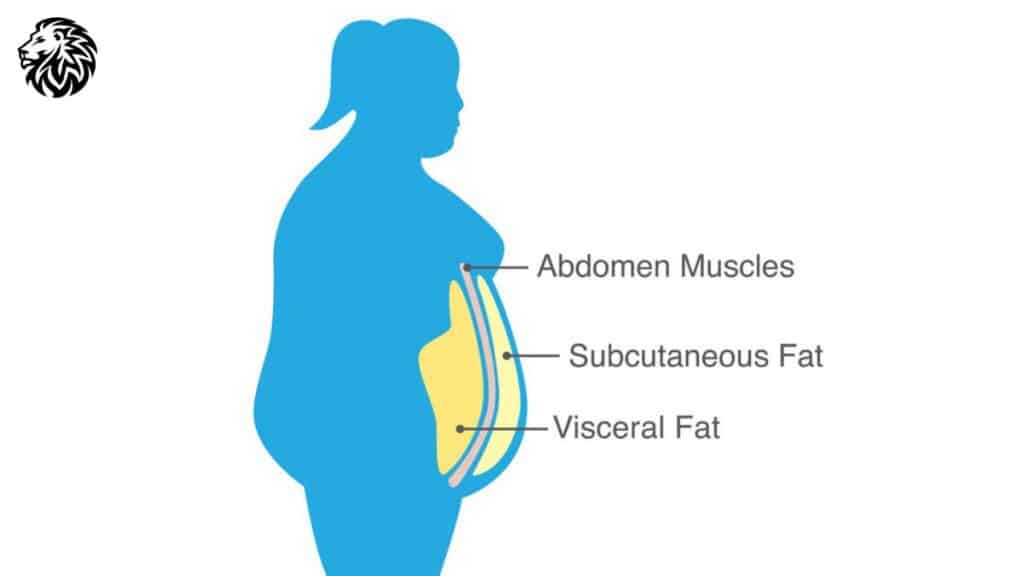In today’s body-conscious society, the pursuit to burn belly fat remains a universal aspiration. A flat or toned stomach is often perceived as a hallmark of fitness and health, frequently showcased in media as an ideal body goal. However, the journey to achieve this often brings to mind grueling diets, calorie counting, or meticulous tracking of macronutrients, leading many to feel overwhelmed before they even begin. But here’s the good news: while these methods can indeed be effective, they’re not the sole avenues to a trimmer waistline. In this article, we’ll explore alternative strategies that can help shed those stubborn inches, without the daunting tasks of dieting or counting macros.
Understanding Belly Fat

Belly fat isn’t just an aesthetic concern; it carries with it specific health implications based on its type and location. Primarily, there are two main categories of belly fat:
- Subcutaneous Fat: This is the fat that sits right under the skin, and it’s the type you can pinch with your fingers. While it may be the more visible kind, especially when one is concerned about their appearance, it’s generally less harmful than its deeper counterpart.
- Visceral Fat: Hidden deeper within the abdomen, visceral fat surrounds vital organs such as the liver, pancreas, and intestines. It’s more metabolically active, which means it can have a more direct impact on health compared to subcutaneous fat.
The health risks associated with excessive belly fat, particularly visceral fat, are manifold:
- Heart Disease: Accumulation of visceral fat has been linked to a higher risk of heart disease, one of the leading causes of death globally.
- Type 2 Diabetes: Excess belly fat can lead to insulin resistance, a key factor in the onset of type 2 diabetes.
- High Blood Pressure: With an increase in belly fat, there’s a greater chance of developing hypertension, a silent killer that can lead to other cardiovascular issues.
- Sleep Apnea: The pressure from excessive visceral fat can cause breathing difficulties, leading to conditions like sleep apnea.
- Certain Cancers: Increased belly fat has been associated with a higher risk of certain cancers, including breast and colorectal cancers.
- Metabolic Syndrome: A collection of conditions that, when occurring together, increase the risk of heart disease, stroke, and type 2 diabetes.
It’s crucial to understand that belly fat isn’t just about appearance. Its presence, especially in excess, can be a tell-tale sign of underlying health issues. Addressing and managing it can lead not just to aesthetic benefits but, more importantly, to a longer, healthier life.
Physical Activity
One of the most direct and effective ways to combat belly fat is through physical activity. Incorporating both cardiovascular exercises and strength training into your routine can offer a balanced approach to fat loss and muscle building.
Cardiovascular Exercise

Cardio, as it’s commonly known, primarily targets the body’s aerobic system, utilizing oxygen to meet energy demands during exercise. Its benefits for fat loss are numerous:
- Calorie Burn: Cardio helps burn calories, leading to a caloric deficit which is essential for fat loss.
- Improved Heart Health: Regular cardio strengthens the heart, allowing it to pump blood more efficiently.
- Increased Metabolism: Post-exercise, the body’s metabolism can remain elevated, burning more calories even at rest.
- Enhanced Mood: Cardio releases endorphins, which are natural mood elevators.
Examples of effective cardiovascular exercises include:
- Walking: An easily accessible form of exercise for all ages, it’s low-impact and can be done anywhere.
- Jogging: A step up from walking, it provides a more intense workout, increasing calorie burn.
- Cycling: Whether on a stationary bike or outdoors, cycling offers an excellent full-body workout.
- Swimming: An all-body workout, swimming is especially beneficial for those with joint issues since it’s low-impact.
Strength Training

While cardio burns calories and helps with immediate fat loss, strength training is crucial for building muscle mass, which has its own set of benefits:
- Higher Resting Metabolic Rate: Muscle tissue consumes more calories at rest compared to fat. So, the more muscle you have, the more calories you burn throughout the day.
- Improved Bone Density: Resistance exercises can help in increasing bone density, reducing the risk of osteoporosis.
- Enhanced Body Composition: As you build muscle and lose fat, your overall body composition improves, leading to a more toned appearance.
When aiming to target belly fat, focusing on core exercises can be beneficial. Some recommended exercises include:
- Planks: A full-body workout that especially targets the core muscles.
- Russian Twists: Great for obliques and overall abdominal muscles.
- Bicycle Crunches: Targets the upper and lower abs, as well as the obliques.
- Leg Raises: Focuses on the lower abdominal muscles.
Remember, while these exercises strengthen the core muscles, spot-reducing fat isn’t possible. A combination of cardio and strength training is the most effective approach to overall fat loss, including the belly area.
Mindful Eating

In a world where every new diet promises quick results, the essence of genuinely listening to and understanding our bodies often gets overshadowed. Mindful eating stands out as an approach that shifts the focus from restriction to awareness and appreciation of food.
Difference Between Dieting and Mindful Eating
- Dieting: Typically involves following a set of external rules regarding what, when, and how much to eat. It often emphasizes restriction, can be short-term, and might lead to a cycle of bingeing and depriving.
- Mindful Eating: Rooted in the practice of mindfulness, it’s about being present during meals, recognizing and honoring body cues, and enjoying the experience of eating without judgment.
Tips for Intuitive Eating
- Listen to Hunger Cues: Understand the difference between true hunger and emotional or boredom-induced eating. Eat when you’re hungry and not because of external factors.
- Eat Slowly: It takes time for the brain to register satiety. By eating slowly, you give your body the chance to signal when it’s had enough.
- Recognize Fullness: Tune into signals your body sends when it’s comfortably full. This can prevent overeating and the discomfort that comes with it.
- Savor Each Bite: By truly tasting and appreciating each bite, you enhance the joy of eating and often find satisfaction in smaller portions.
- Eliminate Distractions: Try to avoid eating while watching TV, working, or driving. Being present during meals allows for better digestion and appreciation of food.
Importance of Hydration
Water plays a pivotal role in almost every function in our body, including metabolism and fat loss:
- Appetite Control: Sometimes, our bodies confuse thirst with hunger. By staying hydrated, we can better discern true hunger cues.
- Boosts Metabolism: Proper hydration aids metabolic processes, including the breakdown and burning of fat.
- Digestion and Detoxification: Water helps in digestion and the elimination of waste, preventing bloating and ensuring a flatter belly.
- Reduced Liquid Calorie Intake: Opting for water over sugary beverages can significantly reduce calorie intake, assisting in fat loss.
Incorporating mindful eating practices can transform our relationship with food. It promotes a balanced and holistic approach to nutrition, ensuring that the journey to a healthier body is also a fulfilling and sustainable one.
Sleep and Stress Management

The journey to a healthier body doesn’t end with diet and exercise; it delves deeper into the intricate balance of sleep and the management of stress, both of which play pivotal roles in weight and overall well-being.
The Role of Sleep in Weight Management and Hormonal Balance
- Hormonal Regulation: Sleep is crucial for regulating hormones that influence appetite, namely ghrelin (which signals hunger) and leptin (which signals fullness). Insufficient sleep can lead to increased ghrelin and decreased leptin levels, resulting in overeating.
- Insulin Sensitivity: Lack of sleep can reduce insulin sensitivity, leading to higher blood sugar levels and increased fat storage.
- Recovery and Muscle Growth: Sleep provides the body with the opportunity to recover and repair. Adequate rest supports muscle growth, which in turn aids metabolism and fat burning.
Impact of Chronic Stress on Belly Fat Storage
- Cortisol Production: Chronic stress leads to prolonged elevated levels of cortisol, a hormone that can prompt fat storage, particularly in the abdominal area.
- Emotional Eating: Stress often leads to seeking comfort in food, especially high-calorie, sugary, or fatty foods, contributing to weight gain.
- Impaired Digestion: Constant stress can hamper digestive processes, leading to bloating and other gastrointestinal issues.
Strategies for Better Sleep Hygiene and Stress Reduction
- Consistent Sleep Schedule: Going to bed and waking up at the same time, even on weekends, helps regulate the body’s internal clock.
- Optimal Sleep Environment: A dark, cool, and quiet room can enhance sleep quality. Consider using blackout curtains, earplugs, or white noise machines.
- Limit Screen Time: The blue light emitted from phones, tablets, and computers can interfere with melatonin production, a hormone responsible for sleep. It’s advisable to reduce screen time at least an hour before bed.
- Meditation: Mindfulness meditation can help calm the mind, reduce stress hormones, and improve sleep quality.
- Deep Breathing Exercises: Techniques like the 4-7-8 method (inhale for 4 seconds, hold for 7, exhale for 8) can reduce anxiety and promote relaxation.
- Ensure 7-9 Hours of Sleep: Most adults require 7-9 hours of sleep for optimal health and functioning.
By understanding and addressing the profound impacts of sleep and stress on our health, we can take comprehensive steps not just towards weight management but also towards a balanced and harmonious life.
Limiting Sugar and Processed Foods

While many factors contribute to weight gain and health issues, sugar and processed foods have garnered significant attention due to their prevalent role in modern diets. Let’s delve into the reasons why limiting these can be a boon for health.
How Excessive Sugar Intake Can Lead to Fat Accumulation
- Spikes in Blood Sugar: Consuming sugary foods causes a rapid increase in blood sugar levels. In response, the body releases insulin to shuttle the sugar into cells. However, when there’s an overload of sugar, insulin stores the excess as fat.
- Empty Calories: Sugary foods and drinks often provide calories without essential nutrients, leading to increased calorie consumption without the feeling of fullness.
- Fat Storage Hormone Activation: High sugar intake stimulates the production of insulin, a hormone responsible for fat storage. Elevated insulin levels can lead to increased fat accumulation, especially around the belly.
Benefits of Whole Foods Over Processed Ones
- Nutrient Density: Whole foods, being unprocessed or minimally processed, retain their natural nutrients, providing the body with essential vitamins, minerals, and antioxidants.
- Better Satiety: Rich in fiber and water content, whole foods can make you feel full quicker and for longer durations, reducing overall calorie intake.
- Fewer Additives: Processed foods often contain additives, preservatives, and artificial ingredients that can have negative health effects in the long run.
Quick Tips for Making Healthier Food Choices Without Strict Dieting
- Read Labels: Check product labels for added sugars, unhealthy fats, and sodium. Common names for added sugars include high fructose corn syrup, cane sugar, and agave nectar.
- Increase Water Intake: Drinking water before meals can help in feeling full and reducing the consumption of sugary beverages.
- Opt for Natural Sweeteners: Consider using honey, maple syrup, or stevia instead of refined sugars.
- Prioritize Whole Grains: Choose brown rice, quinoa, and whole wheat bread over their refined counterparts.
- Cook at Home: Preparing meals at home gives you control over ingredients, allowing you to limit sugar and processed items.
- Limit Packaged Snacks: Opt for fresh fruits, nuts, or yogurt when hungry between meals rather than reaching for chips or cookies.
Incorporating these tips and understanding the impact of sugar and processed foods can pave the way for healthier eating habits. By focusing on whole foods and being mindful of sugar intake, one can achieve better health outcomes without resorting to rigid dieting.
Increasing Protein and Fiber Intake

Protein and fiber are two key nutrients that play a fundamental role in various bodily functions, weight management, and overall health. Prioritizing their intake can bring about numerous benefits.
Benefits of Protein
- Satiety: Protein takes longer to digest, leading to increased feelings of fullness, which can help in reducing overall calorie consumption.
- Muscle Repair and Growth: Protein provides the essential amino acids required for repairing and building muscles, especially after physical activity.
- Higher Thermic Effect: The body uses more energy (calories) to digest protein compared to fats or carbohydrates. This phenomenon, known as the thermic effect of food, results in a higher calorie burn after a protein-rich meal.
Benefits of Fiber
- Digestion: Dietary fiber aids in promoting regular bowel movements and preventing constipation.
- Fullness: High-fiber foods increase the feeling of fullness, helping to curb overeating.
- Blood Sugar Control: Fiber slows the absorption of sugar, leading to more stable blood sugar levels and reduced insulin spikes.
Natural Sources of Protein to Incorporate into Meals
- Lean Meats: Chicken, turkey, and lean cuts of beef and pork are excellent sources of protein.
- Fish: Salmon, tuna, mackerel, and sardines are not only rich in protein but also provide essential omega-3 fatty acids.
- Eggs: A versatile and economical source of protein, eggs can be incorporated into various dishes.
- Dairy Products: Greek yogurt, cheese, and milk offer good amounts of protein.
- Plant-based Sources: Lentils, chickpeas, black beans, tofu, and tempeh are great protein sources for vegetarians and vegans.
Natural Sources of Fiber to Incorporate into Meals
- Whole Grains: Oats, quinoa, barley, and whole wheat bread or pasta are rich in fiber.
- Fruits: Berries, apples (with skin), pears, and oranges are delicious and fiber-packed.
- Vegetables: Broccoli, Brussels sprouts, carrots, and spinach are fiber-rich veggies.
- Legumes: Lentils, chickpeas, and black beans are not only good sources of protein but also high in fiber.
- Nuts and Seeds: Almonds, chia seeds, and flaxseeds are nutrient-dense and provide a good amount of fiber.
By integrating more protein and fiber into daily meals, individuals can naturally support weight management, maintain muscle mass, and ensure smooth digestive processes. This approach aligns with the idea of nourishing the body with whole, nutrient-rich foods rather than relying on dietary restrictions.
Lifestyle Habits

While food choices play a critical role in our health, lifestyle habits equally shape our well-being. Let’s explore the importance of staying active, understanding the implications of alcohol and smoking, and their impacts on belly fat and overall health.
Importance of Regular Physical Activity and Avoiding Sedentary Behavior
- Boosts Metabolism: Engaging in physical activity increases metabolic rate, helping the body burn calories more efficiently.
- Muscle Tone and Strength: Regular exercise, especially strength training, helps in building and maintaining muscle mass.
- Mood Enhancement: Physical activity releases endorphins, which act as natural painkillers and mood elevators.
- Combating Sedentary Lifestyles: Prolonged sitting has been linked to various health issues, including increased belly fat. Breaking up sedentary time with short bursts of activity or regular standing can mitigate these risks.
Impact of Alcohol on Belly Fat and Metabolism
- Empty Calories: Alcoholic drinks are often high in calories without providing any essential nutrients, leading to weight gain.
- Appetite Stimulant: Alcohol can stimulate appetite, leading to overeating.
- Liver Function: Excessive alcohol can interfere with the liver’s ability to metabolize fats, promoting fat storage.
- Distribution of Fat: Alcohol can change the way the body metabolizes food, leading to fat being stored predominantly in the belly. This phenomenon gives rise to the term “beer belly.”
The Role of Smoking and its Correlation with Increased Belly Fat
- Appetite Suppression: Nicotine can suppress appetite, leading to decreased food consumption. However, when a person quits smoking, there’s often weight gain as appetite returns to normal.
- Metabolic Rate: While smoking might increase the metabolic rate slightly, it’s not a healthy or sustainable way to boost metabolism.
- Hormonal Imbalance: Smoking can disrupt hormonal balance, leading to the storage of fat, especially in the abdominal region.
- Visceral Fat: Studies have indicated that smokers tend to have a higher amount of visceral fat (the dangerous fat surrounding internal organs) compared to non-smokers.
Adopting a holistic approach that combines nutritious eating with healthy lifestyle habits can have a profound impact on one’s health. By understanding the broader picture, individuals can make informed choices that not only reduce belly fat but also contribute to overall well-being and longevity.
Consistency Over Perfection
The journey to better health and fitness is often viewed through a lens of strict rules and relentless discipline. However, adopting an approach of consistency over perfection can be far more rewarding and sustainable in the long run.
Understanding that Occasional Indulgences are Okay
- Mental Well-being: Allowing oneself occasional treats can help prevent feelings of deprivation, reducing the risk of binge eating.
- Balanced Relationship with Food: Recognizing that no food is inherently “bad” and enjoying treats in moderation can foster a healthier, guilt-free relationship with food.
- Metabolic Boost: Some argue that occasional indulgences, or “cheat meals,” can potentially give a temporary boost to the metabolism, though this concept is still debated among experts.
The Importance of Developing Sustainable Habits Over Short-Term Diets
- Long-term Results: Fad diets might offer quick results, but they’re often hard to maintain and can lead to the notorious “yo-yo effect.” Sustainable habits, on the other hand, pave the way for lasting changes.
- Nutritional Balance: Instead of cutting out entire food groups, a sustainable approach ensures a balanced intake of all essential nutrients.
- Adaptability: Life is unpredictable. Developing flexible habits ensures that one can adapt to different situations without completely derailing their health goals.
Emphasis on Progress Over Perfection
- Realistic Expectations: Perfection is an unattainable goal, and striving for it can lead to frustration and burnout. Celebrating small wins and recognizing progress can be more motivating.
- Learning from Mistakes: Instead of berating oneself for slip-ups, they can be viewed as learning opportunities. Understanding what triggered a setback can help in devising strategies to prevent it in the future.
- Continuous Growth: Health and fitness are ongoing journeys. Emphasizing progress means recognizing that there’s always room for growth and improvement, fostering a growth mindset.
In the grand scheme of things, consistency is the key. While perfection might be a fleeting aspiration, maintaining a consistent approach towards health and wellness ensures that the journey is enjoyable, rewarding, and, most importantly, lifelong.
Conclusion
Burning belly fat and achieving a desired physique isn’t solely about stringent diets or exhaustive exercise regimens. Instead, it’s about embracing a holistic approach that encompasses nutrition, physical activity, mental well-being, and sustainable lifestyle choices. While the roadmap might vary for each individual, the underlying principles remain the same.
It’s crucial to remember that everyone’s journey is unique. Factors such as genetics, metabolism, and personal preferences play a significant role in determining what might work best for one individual compared to another. As such, it’s essential to experiment, listen to your body, and find the strategies and habits that resonate with your lifestyle and aspirations.
In the quest for better health, the journey is equally, if not more, important than the destination. Stay consistent, be patient with yourself, and cherish the progress you make along the way. Your commitment to your well-being is the ultimate investment in yourself, promising not just a trimmer waistline but a richer, fuller life.







